If you’re a lover of language, there’s nothing that holds a candle to Shakespearean prose. (This is, after all, the man who gave us leapfrog, dead as a doornail, What’s done is done, To be or not to be, and A horse! A horse! My kingdom for a horse!, to say nothing of the immortal Let’s kill all the lawyers.)
See below for all (well, a lot) on the Bard, including Shakespeare in fiction, Shakespeare’s poems and plays, helps for performing Shakespeare, and info on Shakespearean sports, games, gardens, and feasts. See “Seriously Quirky Shakespeare” for Shakespeare and Star Wars, Shakespearean baseball, and the impressive Shakespeare Rubber Duck.
Table of Contents
FUN FICTION
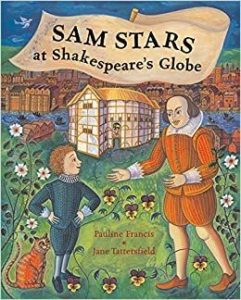
|
Pauline Francis’s Sam Stars at Shakespeare’s Globe (Frances Lincoln Children’s Books, 2009) is the picture-book story of young Sam who wants to act in the company of William Shakespeare, the greatest writer in England. Eventually he convinces Shakespeare to take him on, and works his way from part to part until he (with a bit of luck) wins the coveted role of Juliet. (The book explains that boys played the parts of girls and women on the Elizabethan stage.) For ages 4-8. |
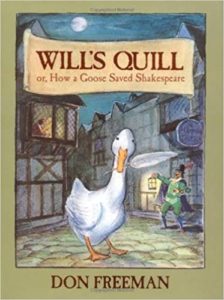
|
Don Freeman’s Will’s Quill (Viking Juvenile, 2004) is the delightful picture-book tale of Willoughby Waddle, an adventurous goose, who sets off for London, where he is befriended by young Will Shakespeare. There’s a disastrous episode in which Will (goose) attempts to save Will (playwright/actor) from a stage duel, but all ends happily, when the goose – with a gift of feathers – is able to help his new friend. For ages 5-9. |
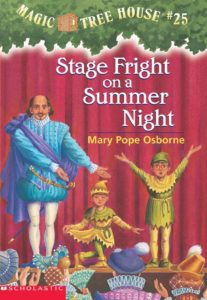
|
In Mary Pope Osborne’s Stage Fright on a Summer Night (Random House Books for Young Readers, 2002) – one of the Magic Treehouse Series – Jack and Annie are whizzed back to Elizabethan England, where they meet William Shakespeare, save a bear, and appear in a performance of “A Midsummer Night’s Dream.” For ages 5-9. |
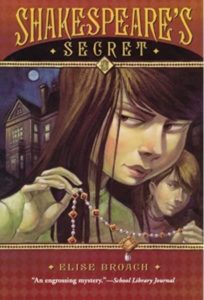
|
In Elise Broach’s Shakespeare’s Secret (Square Fish, 2007), Hero is named for a character in Much Ado About Nothing – but her new classmates think the name “Hero” sounds more like a dog. Lonely and left out, Hero makes friends with Mrs. Roth, an eccentric neighbor, who tells her the story of the missing “Murphy Diamond,” said once to have belonged to Anne Boleyn. With the help of an eighth-grader named Danny, Hero sets out to solve the mystery of the diamond – discovering a lot along the way about Elizabethan life, William Shakespeare, and the controversy over who really wrote Shakespeare’s plays. For ages 9-12. |
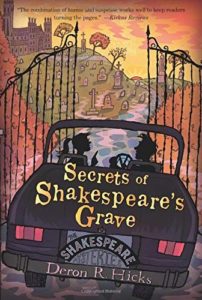
|
In Deron R. Hicks’s Secrets of Shakespeare’s Grave (Houghton Mifflin Harcourt, 2013). 12-year-old Colophon Letterford is off to save the family publishing business by tracking down a mysterious Elizabethan treasure. (Each chapter begins with a quote from Shakespeare.) For ages 9-12. |
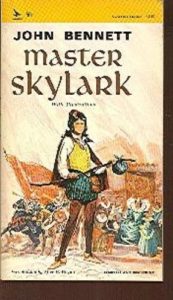
|
John Bennett’s Master Skylark (Forgotten Books, 2012) was originally published in 1897. The main character, young Nick Attwood, a boy with a voice like a skylark, runs away to see a play and ends up forced to perform with the Lord Admiral’s Men, a group of traveling players, under the thumb of Gaston Carew. Eventually he arrives in London, meets Will Shakespeare, sings before the queen, and all ends happily. (The last chapter is titled “All’s Well That Ends Well.”) It’s a delightful, old-fashioned read for ages 9-12. |
| The entire text of Master Skylark is online at Project Gutenberg. | |
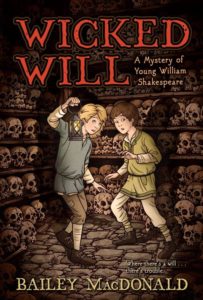
|
In Bailey MacDonald’s Wicked Will (Aladdin, 2009), a troupe of strolling players arrives in Stratford, among them 13-year-old Viola (a.k.a. Tom), who travels disguised as a boy. When Viola’s uncle is accused of murder, she joins forces with theatre-obsessed 12-year-old William Shakespeare, and together they devise a plot to discover the true culprit, involving an imaginative script written by Will, and Viola disguised as a ghastly ghost. For ages 9-13. |
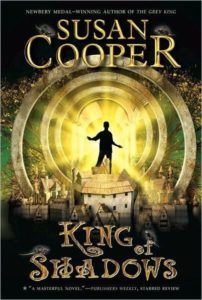
|
In Susan Cooper’s King of Shadows (Margaret K. McElderry Books, 2001), orphaned Nat Field, in London to play Puck in a new production of A Midsummer Night’s Dream, travels back in time to Elizabethan England where he meets Shakespeare. For ages 10 and up. |
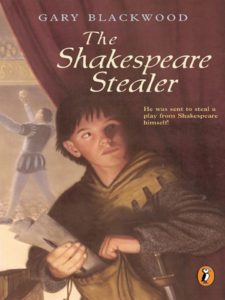
|
Gary Blackwood’s The Shakespeare Stealer (Puffin, 2000) is the story of Widge, an orphan, whose unscrupulous master sends him to the Globe Theater to steal Shakespeare’s latest play (Hamlet). Despite this, Widge eventually finds new friends and ends up a member of the Globe company. Sequels include Shakespeare’s Scribe and Shakespeare’s Spy. For ages 10 and up. |
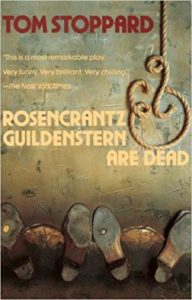
|
Tom Stoppard’s acclaimed play Rosencrantz and Guildenstern Are Dead (Grove Press, 1994) is a brilliant version of Hamlet, told from the unexpected points of view of minor characters Rosencrantz and Guildenstern – old school friends of Hamlet, summoned by the King, his uncle, to cheer the depressed prince up. When this fails, they’re ordered to kill him, but Hamlet manages to turn the tables on them. A good pick for high-school-level literature classes, and a great discussion promoter. |
| The film version of Rosencrantz and Guildenstern Are Dead (1990), directed by Tom Stoppard, stars Gary Oldman and Tim Roth as the title characters. Rated PG. | |
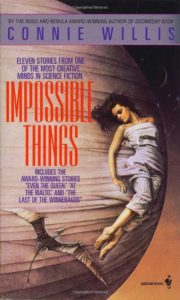
|
Connie Willis’s short story “Ado,” which appears in her creative sci-fi collection Impossible Things (Spectra, 1993), is set in a super-politically-correct future where the plays of Shakespeare are banned due to multiple protests (the International Federation of Florists objects to Hamlet because Ophelia fell into the water and drowned while picking flowers; the National Cutlery Council objects to the depiction of swords as deadly weapons). In the same collection, see “Winter’s Tale,” Willis’s take on who really wrote Shakespeare. For teenagers and adults. |
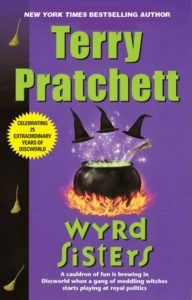
|
Terry Pratchett’s Wyrd Sisters (Harper, 2013), a fantastic and hilarious concoction of Shakespeare and fairy tale, features the three witches – Granny Weatherwax, Nanny Ogg, and Magrat Garlick – along with a host of other characters, among them the wicked Duke Felmet (who has murdered King Verence), Hwel, a dwarf playwright, and young Tomjon who – though he doesn’t know it – is the rightful heir to the throne. One of the wonderful Discworld series. For ages 12 and up. |
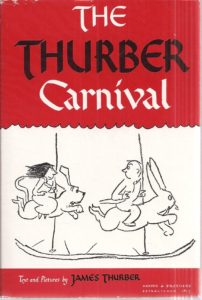
|
For mystery-minded readers, see James Thurber’s hilarious short story “The Macbeth Murder Mystery” in The Thurber Carnival (Harper & Brothers, 1945) – the Macbeths, it turns out, were (!) totally innocent. Read it online here. |
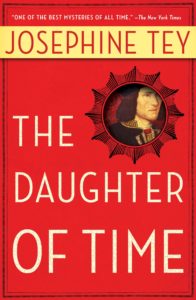
|
In Josephine Tey’s Daughter of Time (Scribner, 1995), detective Alan Grant – confined to a hospital bed with a broken leg – tackles the mystery of Richard III. (Did Richard really murder the little princes in the Tower? Is Shakespeare’s Richard historically correct?). For ages 12 and up. |
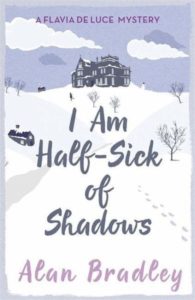 |
Alan Bradley’s I Am Half-Sick of Shadows (Bantam, 2012) – one of the terrific Flavia de Luce mystery series – is set in the 1950s in a crumbling mansion in England, and features precocious eleven-year-old chemist Flavia de Luce and her eccentric family. Here, Flavia’s father, the financially strapped Colonel de Luce, had agreed to rent out the family home to a film company just before Christmas. Featured, along with Flavia’s chemistry-based plans to prove the existence of Father Christmas, is a fatal re-enactment of the balcony scene from Romeo and Juliet. For ages 13 and up. |
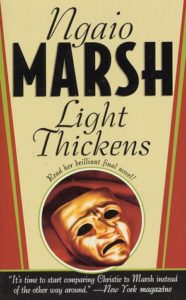
|
In mystery writer Ngaio Marsh’s Death at the Dolphin (HarperCollins, 1999), the plot revolves around a restored theater, a Shakespeare performance, and a rare antique glove, once owned by Shakespeare’s son Hamnet. Also by Marsh, see Light Thickens (Jove, 1992), which features a performance of Macbeth and a legendary Scottish sword. For teenagers and adults. |
| For many more mystery resources, see Mysteries. (Reading mysteries makes you smarter.) |
